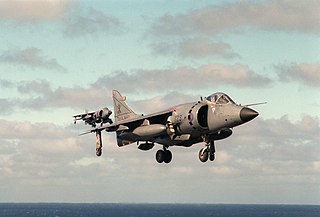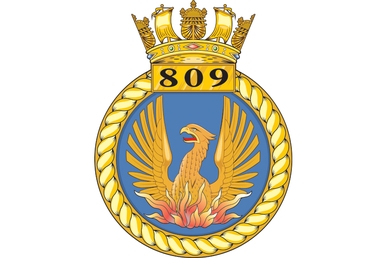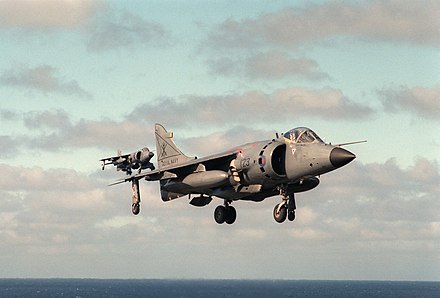
The Fleet Air Arm (FAA) is one of the five fighting arms of the Royal Navy and is responsible for the delivery of naval air power both from land and at sea. The Fleet Air Arm operates the F-35 Lightning II in a Maritime Strike Role, the AW159 Wildcat and AW101 Merlin in both Commando and Anti-Submarine roles, and the BAE Hawk in an aggressor role.

The Harrier, informally referred to as the Harrier Jump Jet, is a family of jet-powered attack aircraft capable of vertical/short takeoff and landing operations (V/STOL). Named after a bird of prey, it was originally developed by British manufacturer Hawker Siddeley in the 1960s. The Harrier emerged as the only truly successful V/STOL design of the many attempted during that era. It was a subsonic aircraft, unlike most of its competitors. It was conceived to operate from improvised bases, such as car parks or forest clearings, without requiring large and vulnerable air bases. Later, the design was adapted for use from aircraft carriers.

During the 1982 Falklands War, Operations Black Buck 1 to Black Buck 7 were a series of seven extremely long-range ground attack missions by Royal Air Force (RAF) Vulcan bombers of the RAF Waddington Wing, comprising aircraft from Nos. 44, 50 and 101 Squadrons against Argentine positions in the Falkland Islands, of which five missions completed attacks. The objective of the missions was to attack Port Stanley Airport and its associated defences. The raids, at almost 6,600 nautical miles (12,200 km) and 16 hours for the return journey, were the longest-ranged bombing raids in history at that time.

This article describes the composition and actions of the Argentine air forces in the Falklands War, which comprised units of the Air Force, Army, Navy and other services.

The British Aerospace Sea Harrier is a naval short take-off and vertical landing/vertical take-off and landing jet fighter, reconnaissance and attack aircraft; the second member of the Harrier Jump Jet family developed. It first entered service with the Royal Navy in April 1980 as the Sea Harrier FRS1 and became informally known as the "Shar". Unusual in an era in which most naval and land-based air superiority fighters were large and supersonic, the principal role of the subsonic Sea Harrier was to provide air defence for Royal Navy task groups centred around the aircraft carriers.
A Naval Flight Officer (NFO) is a commissioned officer in the United States Navy or United States Marine Corps who specializes in airborne weapons and sensor systems. NFOs are not pilots per se, but they may perform many "co-pilot" functions, depending on the type of aircraft. Until 1966, their duties were performed by both commissioned officer and senior enlisted naval aviation observers (NAO).

Marine Attack Squadron 223 (VMA-223) is a United States Marine Corps fixed wing attack squadron that consists of McDonnell-Douglas AV-8B Harrier II (V/STOL) jets. The squadron is based at Marine Corps Air Station Cherry Point, North Carolina and falls under the command of Marine Aircraft Group 14 (MAG-14) and the 2nd Marine Aircraft Wing. The squadron uses "Stone" as its radio callsign.
The history of the Royal Air Force, the air force of the United Kingdom, spans a century of British military aviation.
Sir Peter Ted Squire, was an Air Chief Marshal of the United Kingdom's Royal Air Force, who held the post of Chief of the Air Staff from 2000-2003. In retirement he was the Chairman of the Board of Trustees of the Imperial War Museum, and Vice-Chairman of the Board of the Commonwealth War Graves Commission.

800 Naval Air Squadron was a Royal Navy Fleet Air Arm carrier-based squadron formed on 3 April 1933 by amalgamating No's 402 and 404 Flights.
Commander Nigel David "Sharkey" Ward,, born Nigel David MacCartan-Ward, is a retired British Royal Navy officer who commanded 801 Naval Air Squadron during the Falklands War.

This is a list of the units, aircraft and casualties of the British air services in the Falklands War. The numbers in bold are the number of aircraft used in the war, the numbers in brackets are the number of lost aircraft. For a list of air forces from Argentina, see Argentine air forces in the Falklands War.

Admiral Arun Prakash, PVSM, AVSM, VrC, VSM, ADC is a former Flag Officer of the Indian Navy, who served as the Chief of the Naval Staff from 31 July 2004 to 31 October 2006 and as the Chairman of the Chiefs of Staff Committee from 31 January 2005 to 31 October 2006. He is one of India's most decorated naval officers.
801 Naval Air Squadron (NAS) was a Fleet Air Arm squadron of the Royal Navy formed in 1933 which fought in World War II, the Korean War and the Falklands War.

809 Naval Air Squadron is a squadron of the Fleet Air Arm of the United Kingdom. It was formed in 1941 and flew in the Soviet Union, the Mediterranean and the Far East during World War II. After active service during the Suez Crisis, 809 was disbanded in 1959. Reformed in 1963 to fly Buccaneers, the squadron was disbanded briefly in 1965-66, and then again in 1978. A brief period during the Falklands war saw 809 reformed to bring Sea Harrier aircraft south to the UK task group and to fly from Illustrious.

The Ferranti Blue Fox was a British multi-role airborne radar designed and built for the Royal Navy by Ferranti Defence Systems in the late 1970s. It had a mixed record in service, and was replaced by the more capable Blue Vixen.

Captain Roberto Curilovic is a former Argentinian Navy pilot. His attack on 25 May 1982 in the Falklands War sank the transport ship Atlantic Conveyor with an Exocet AM.39 anti-ship missile.

The 8th Air Brigade was an Argentine Air Force brigade that existed between 1976 and 1988 based on Mariano Moreno airport near Buenos Aires. It was created upon the procurement of Mirage III fighters planes and fought during the Falklands War.
David Henry Spencer Morgan is a former British Navy and RAF pilot who flew on attachment to the Fleet Air Arm of the Royal Navy during the Falklands War in 1982 where he became the most successful British fighter pilot of the conflict and was also involved in the last dogfight by British fighter pilots in which enemy aircraft were destroyed.













